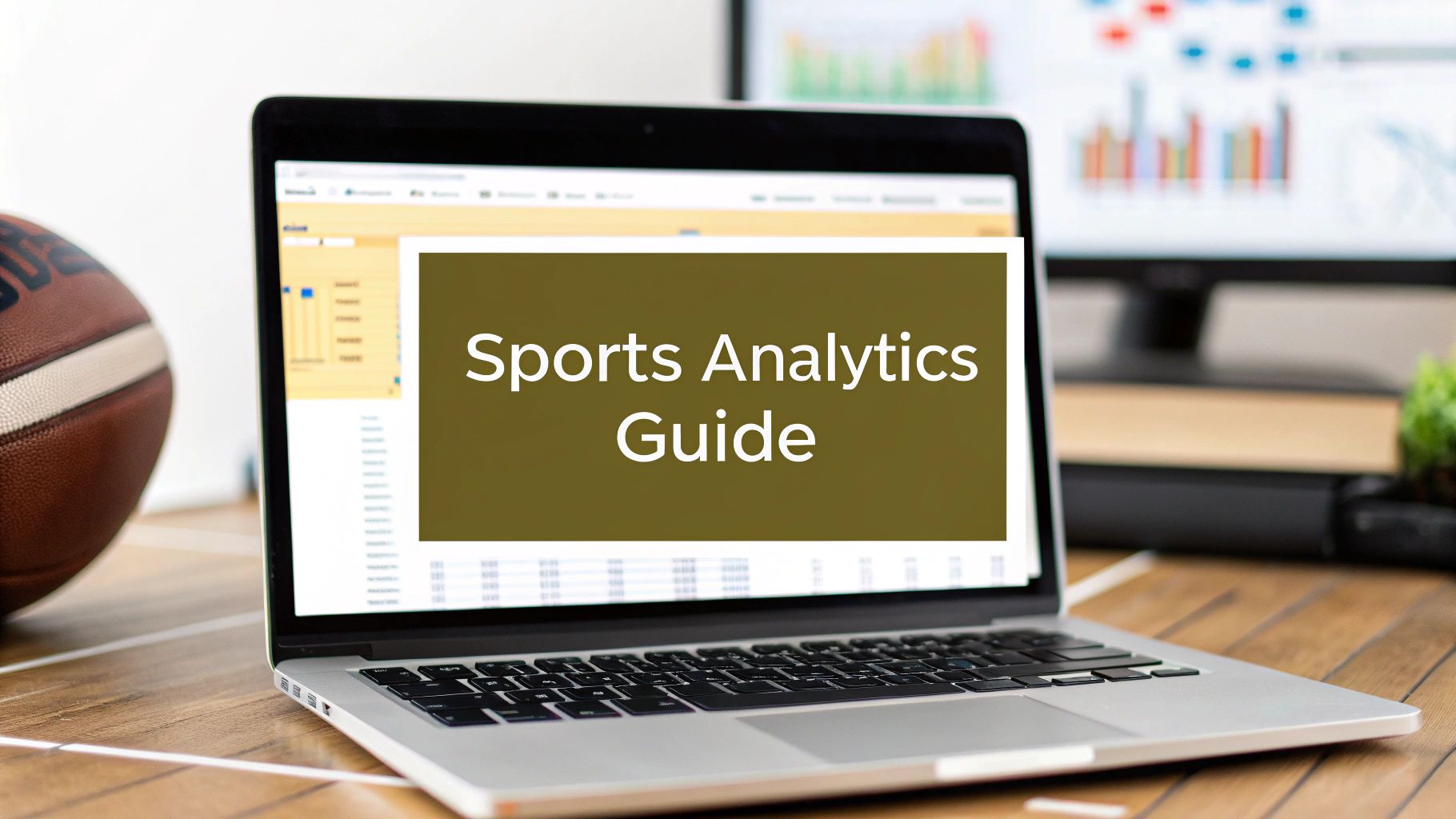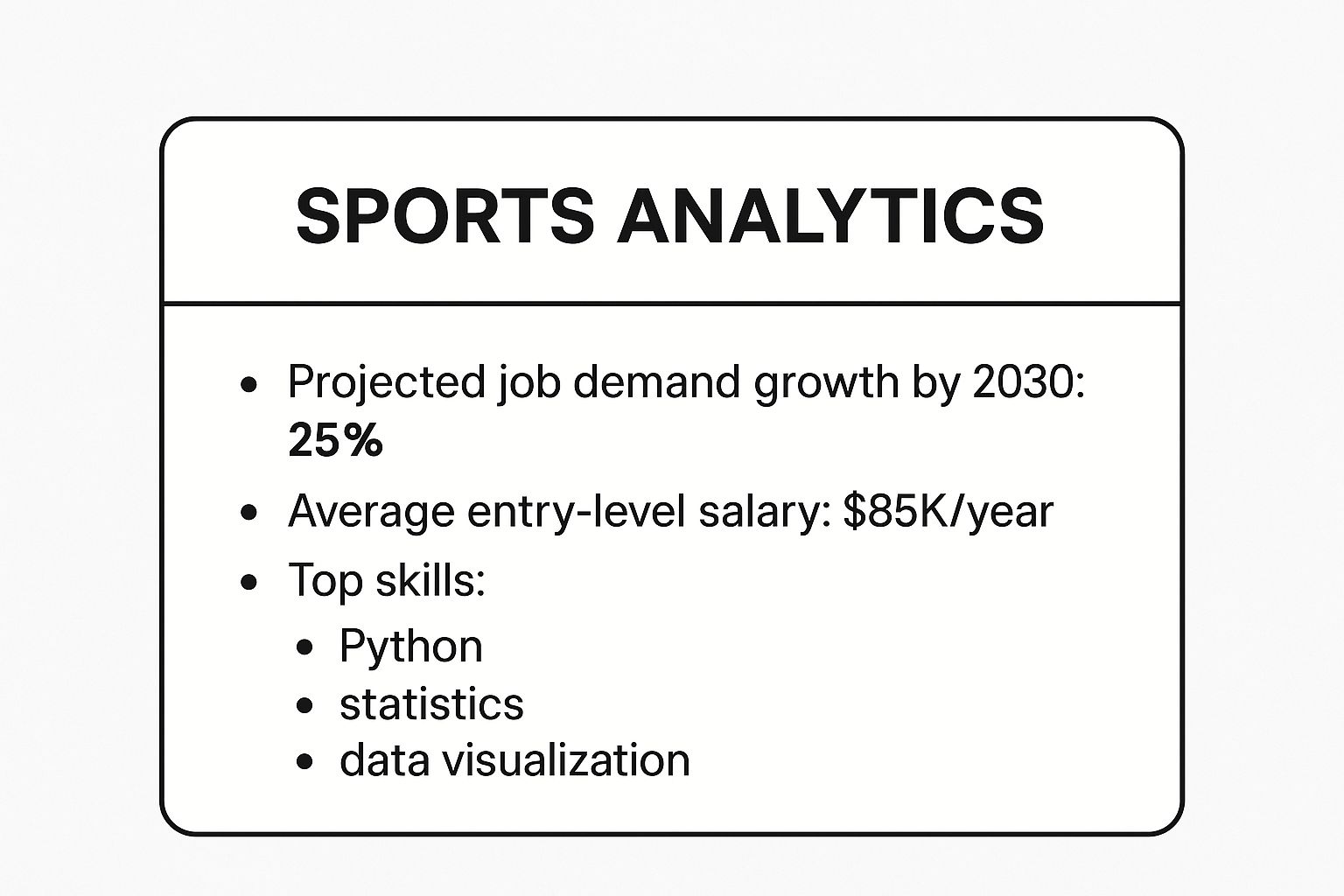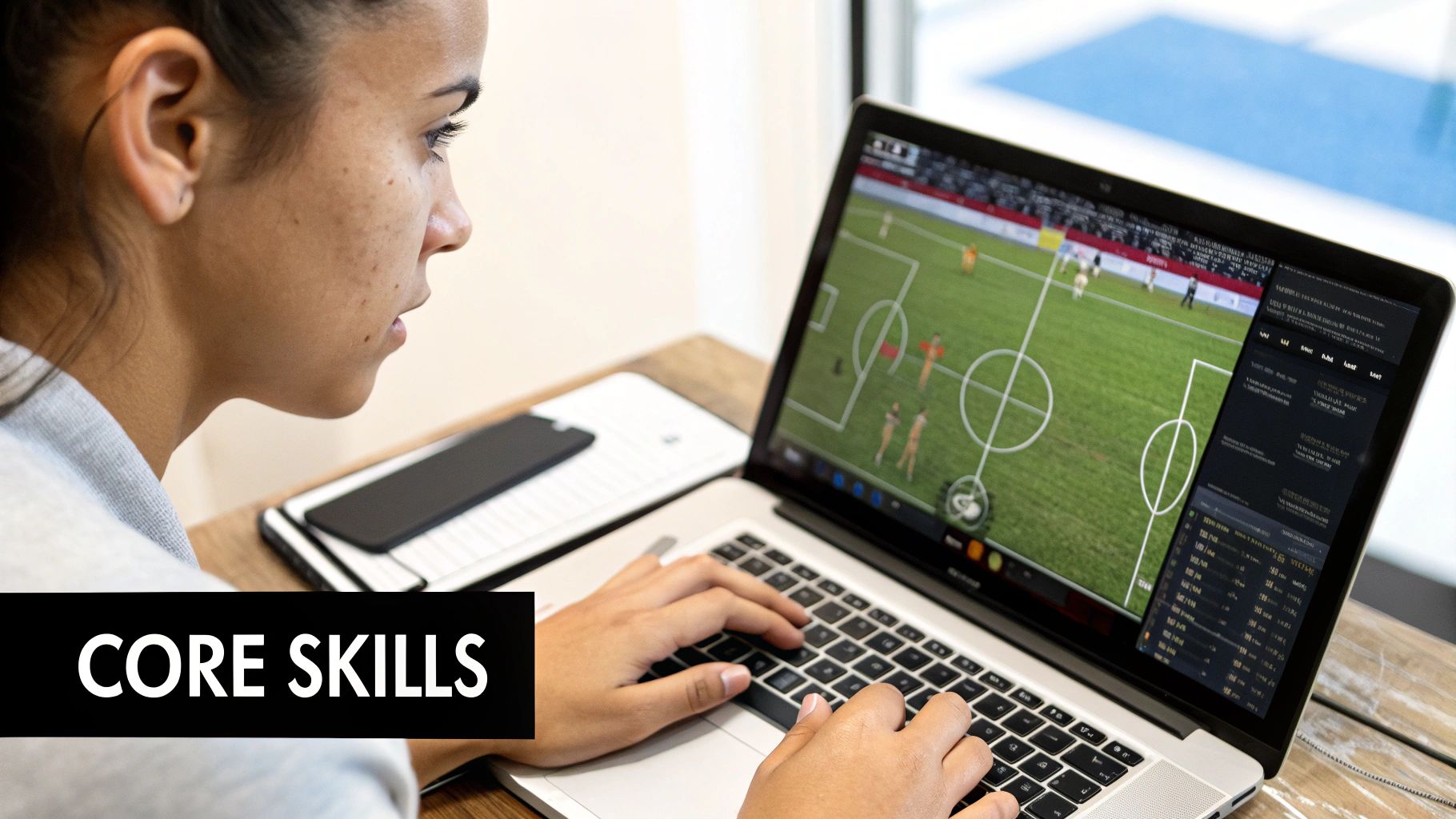
How to Get Into Sports Analytics and Land Your Dream Job
So, you want to get into sports analytics? Good choice. It's a fantastic field that perfectly blends sharp quantitative skills, a bit of coding wizardry, and a genuine, die-hard passion for the game.
But let's be real: while the field is absolutely booming, breaking in requires more than just a degree. It’s all about what you can do. This guide is your playbook, designed to give you a clear roadmap to navigate this exciting career.
Understanding the Sports Analytics Landscape
Forget the old days of relying purely on gut feelings and traditional scouting. The entire world of sports is going through a massive data-driven transformation. Teams and organizations are now building whole departments just to find that tiny competitive edge hidden in the numbers.
This means your journey into sports analytics isn't just timely—it's essential for the future of the industry.
Your job is to be a translator. You’ll take raw data—like player tracking coordinates from a game or a million rows of shot attempt locations—and turn it into something a coach or GM can actually use. It’s one thing to know your way around Python, but it's a whole different ball game to use it to explain why a certain defensive scheme is crushing a specific opponent's offense.
Why the Demand Is Surging
The reason for this explosion is simple: it works. Analytics helps teams find undervalued players in the draft, optimize ticket prices to fill stadiums, and even develop new strategies to prevent player injuries. This isn't just a fad; it's a fundamental shift in how the business of sports operates.
The numbers back it up. The global sports analytics market is on a crazy growth trajectory, expected to rocket from around $5.43 billion in 2025 to nearly $29.36 billion by 2034. That surge tells you everything you need to know about the opportunities waiting for skilled analysts. You can dig deeper into this market growth and its drivers to see for yourself.
The infographic below really puts it into perspective, highlighting the demand, the salaries, and the core skills you'll need.

As you can see, the market is hot. Technical chops in areas like Python and statistics aren't just "nice to have"—they directly lead to high-value career opportunities.
Key Milestones on Your Path
Breaking into this field doesn't happen by accident. You need a structured game plan that takes you from foundational knowledge to real-world application. Think of it like a team's season: you start with training camp, grind through the regular season, and then kick it into high gear for the playoffs. Each stage requires more focus and better execution.
A huge mistake I see people make is going all-in on one area, like coding, while completely ignoring the sport itself. The best analysts are bilingual—they speak both the language of data and the language of the game. They're the critical link between the analytics department and the coaching staff.
To give you a clearer picture, I've broken down the key stages we'll cover in this guide. Think of this as your high-level roadmap.
Key Milestones on Your Path to a Sports Analytics Career
| Milestone | Core Focus | Key Outcome |
|---|---|---|
| Stage 1: Building a Foundation | Mastering core technical skills like Python, statistics, and SQL. | A solid technical toolkit to tackle sports data challenges. |
| Stage 2: Creating Your Portfolio | Developing tangible projects that solve real sports problems. | A "highlight reel" of your work that proves your abilities to employers. |
| Stage 3: Gaining Domain Knowledge | Deeply understanding the tactics, rules, and strategies of your chosen sport. | The ability to provide context and translate data into actionable insights. |
| Stage 4: Networking & Job Hunting | Building connections, acing technical interviews, and navigating the job market. | Landing your first role and officially starting your career in sports analytics. |
This table lays out the journey ahead. We'll dive into each of these milestones, giving you the actionable advice you need to progress from one stage to the next and ultimately land that dream job. Let's get started.
Building Your Technical and Quantitative Foundation
This is the part that separates the fans from the analysts. A passion for sports is what gets you in the door, but your technical and quantitative skills are what will get you the job. Let's move past vague advice like "learn to code" and get into the specific tools that teams and sports data companies are actually hiring for.
Think of it like a coach's playbook. The more plays you have memorized and can run effectively, the more valuable you are on game day. Your technical skills are your playbook.
Mastering the Language of Numbers and Data
Before you even think about writing code, you need to understand the why behind the numbers. It all starts with a solid quantitative foundation. You don't need a Ph.D. in statistics, but you absolutely have to be comfortable with the concepts that drive nearly all of sports analytics.
These are your non-negotiables:
- Probability: This is the bedrock of everything. From calculating a team's playoff odds to figuring out the win probability added by a single play, it all boils down to how likely an event is to happen.
- Regression Analysis: This is how you answer the really interesting questions. How much is one win worth in salary cap dollars? Does a quarterback's 40-yard dash time actually predict on-field success? Regression is what helps you find the relationships between different variables.
- Statistical Significance: You have to know if what you found is a real trend or just random noise. Understanding things like p-values and confidence intervals is what separates a genuine insight from a totally meaningless observation.
I once saw a junior analyst proudly present a finding that a certain shot location in basketball led to more wins. The problem? They didn't account for the fact that only the team's best players were taking those shots. The insight wasn't about the location; it was about the players. A solid grasp of stats keeps you from making these kinds of critical mistakes.
Choosing Your Programming Weapons
Once you have the statistical framework, you need the tools to actually put it to work. In the world of sports analytics, two languages run the show: Python and SQL. They do different things, but both are absolutely essential.
Python: The All-Purpose Powerhouse
Python is the king of data analysis for good reason. It’s relatively easy to read, and its collection of libraries is the industry standard for everything from cleaning messy data to building sophisticated machine learning models.
You’ll get very familiar with the official Python website.

This simple page is your gateway to a whole ecosystem of tools that are at the heart of modern sports analytics.
If you're just starting out, put your energy into these key Python libraries:
- Pandas: This is your workhorse for data manipulation. You will use this every single day to load, clean, filter, and reshape data—like turning raw play-by-play logs into a clean, usable format.
- NumPy: The engine for any heavy-duty math in Python. It's the foundation for almost any numerical or statistical task you'll perform.
- Matplotlib & Seaborn: These are for data visualization. You'll use them to make everything from simple bar charts of team stats to complex shot charts and heatmaps that tell a story.
- Scikit-learn: Your first step into machine learning. This is what you'll use to build predictive models, like forecasting a player's future output or classifying different types of plays.
SQL: The Unsung Hero
While Python is for analyzing the data, Structured Query Language (SQL) is for getting the data in the first place. Every team, league, and data provider you can think of stores its information in massive databases. SQL is the universal language for talking to them.
Knowing SQL means you can pull the exact data you need—say, every third-down pass by a specific quarterback against a specific defensive coverage—without having to bother a data engineer. That kind of independence is huge. Your ability to write clean, efficient SQL queries will make you a much more effective analyst from day one. In fact, many roles like a game data analyst list SQL right alongside Python as a core requirement.
The sports analytics market is growing fast, projected at a CAGR of over 20% for the next decade, which means more job opportunities are popping up that demand these exact skills. If you're curious, you can explore in-depth market research on sports analytics growth to see the trends. Building this technical foundation isn't just a good idea; it's a direct response to what the industry is asking for.
Creating a Portfolio That Gets You Hired

Your technical skills are your tools, but your portfolio is your highlight reel. Plain and simple, it's the single most important asset you will build on your journey into sports analytics. This is where you prove to hiring managers that you can do more than just follow instructions—you can solve real, meaningful problems.
Forget mindlessly cranking out generic tutorials that thousands of other aspiring analysts have already done. A truly standout portfolio is born from genuine curiosity. It tackles interesting questions and shows off not just what you can do with code, but how deeply you understand the sport you love.
Finding Projects That Turn Heads
The absolute best portfolio projects start with a question you actually want to answer. You have to think like a fan but work like an analyst. The goal here is to show you've got the whole package: technical chops, sports savvy, and a creative approach to problem-solving.
Need a little inspiration to get the ball rolling?
- Predictive Modeling: Don't just predict wins and losses. That's been done. Try building a model to forecast a player's future production based on aging curves. Or, create a composite score from various performance metrics to predict the next Ballon d'Or winner.
- Player Evaluation: Dig into play-by-play data to find undervalued guys. For example, which NFL running backs grind out the most yards after contact, completely separate from how good their offensive line is? That shows you can isolate individual talent.
- Tactical Analysis: Use NBA player tracking data to really measure defensive impact. You could quantify how well a player contests shots or even how their mere presence on the court stops opponents from driving to the basket.
- Financial Analytics: What about building a model to project MLB player salaries in arbitration? You could factor in both old-school stats and advanced metrics to show you understand the business side of the game.
Your portfolio needs to tell a story. It's not just a collection of code snippets. It’s a full demonstration of how you think, how you attack a problem from start to finish, and most importantly, how you communicate what you found. The narrative is just as crucial as the numbers.
Pulling off a project like this from concept to conclusion shows you can handle the entire analytics workflow. That's a must-have skill for roles like a Principal Data Analyst, where leading projects is the name of the game.
Where to Find High-Quality Datasets
Good news: you don't need a front-office keycard to get your hands on fantastic data. The internet is overflowing with rich, free datasets if you just know where to look. Getting your hands dirty with real-world data is a massive step in figuring out how to get into sports analytics.
These are some of my go-to spots:
- StatsBomb: An unbelievable resource for free soccer data. They provide incredibly detailed event data, including player coordinates for major leagues. It's the gold standard.
- Kaggle: This is a data science competition platform, but it’s packed with sports-related challenges and datasets for everything from NCAA basketball to European soccer.
- Sports-Reference: A family of sites like Baseball-Reference and Basketball-Reference that are absolute treasure troves of historical stats. You can export many of the tables directly.
- nflverse: A fantastic community-driven project providing clean, ready-to-use NFL data. For any aspiring football analyst, this is an indispensable resource.
The key is to pick a dataset that you're actually excited about. Your passion for the topic will absolutely shine through in the quality of your work.
Presenting Your Work Professionally
Your analysis could be the most brilliant thing since the forward pass, but if nobody can see it or understand it, it has zero impact. A professional presentation isn't a "nice to have," it's a must. The two main stages for your work will be GitHub and a personal blog or website.
Your GitHub Profile as a Resume
Think of GitHub as more than just a code locker. It's your public-facing technical resume, and I promise you, hiring managers will look at your profile.
Get your project repositories in order:
- A Clear README File: This is your project's front door. Explain the goal, the methods you used, how to run your code, and summarize what you found.
- Clean, Commented Code: Write your code like someone else has to read it tomorrow—because they will. Use clear variable names and add comments to explain the tricky parts.
- Visualizations: Don't just show tables of numbers. Embed your charts, graphs, and heatmaps right there in the README. Visuals make your findings pop and are way easier to digest.
A Personal Blog for Storytelling
While GitHub is for showing your technical work, a blog is where you prove you can communicate. Write posts that walk people through your projects. Explain your thought process, talk about the hurdles you overcame, and clearly spell out the "so what?" of your findings.
This is your chance to show you can translate complex data into a compelling story—a skill every single team is desperate for. It proves you're not just a coder; you're an analyst who delivers real, actionable insights.
Gaining an Edge with Deep Domain Knowledge

Let's be real. Your technical skills might get you in the door for an interview, but it’s your deep-seated sports knowledge that will make you truly invaluable. The best analysts don’t just stare at spreadsheets; they see the game, the players, and the strategy behind the numbers.
Without that context, even the slickest model is just a black box spitting out figures. Your goal is to be the person who can connect that data to what’s actually happening on the field, court, or track. This is what separates a data scientist who likes sports from a genuine sports analyst.
You need to understand the why behind the what. Why is a certain play call so effective against a specific defense? Why does a player’s performance tank in the final minutes? The answers rarely live in a CSV file alone.
Immersing Yourself in the Sport
Becoming a domain expert isn't something you can check off a list. It's a constant process of active immersion. You have to start consuming the sport from a purely analytical perspective, always asking questions and digging for a deeper understanding.
Your weekly routine has to go beyond just watching the games.
- Devour Tactical Content: Read blogs and websites dedicated to breaking down the Xs and Os. Look for content that explains strategic details, like why a certain formation works in soccer or how an NBA team uses off-ball screens to get a shooter open.
- Listen to Analytical Podcasts: Hunt down podcasts where former players, coaches, or established analysts talk shop. These are absolute goldmines for understanding the thinking that drives in-game decisions.
- Follow the Right People: Clean up your social media feeds. Follow sports data scientists, journalists who specialize in analytics, and even those team-specific bloggers who provide incredibly deep insights. Their conversations will clue you into the latest trends and debates.
This isn't passive learning. You're training your brain to see the game through an analytical lens. Soon, you’ll start instinctively connecting the plays you see on TV with the data on your computer. That’s the magic moment.
The Power of Niche Expertise
The sports world is massive. If you try to be an expert in everything, you'll end up being an expert in nothing. A much smarter strategy, especially when you're starting out, is to specialize. Find a niche and become the go-to person for it.
Think about it from a team's point of view. They aren't just looking for "a data analyst." They have specific problems. They need someone who can help them evaluate defensive linemen or figure out their corner kick strategy. A niche makes you the solution to a specific problem.
Specializing doesn't limit your opportunities; it focuses them. If you become the world’s foremost expert on analyzing goaltender performance in hockey with tracking data, every single NHL team with an analytics department is going to know who you are. That’s way more powerful than having a generic understanding of all sports.
Finding Your Specialization
So, how do you pick a niche? Simple: start with what genuinely fascinates you. Your passion is the fuel you'll need to do the deep dive required to become a real expert.
Here are a few real-world examples of how you can set yourself apart:
- Basketball Player Evaluation: Don't just do general analysis. Focus specifically on evaluating a draft prospect's defensive potential using their college stats and biomechanics data.
- Soccer Set-Piece Analysis: Become the authority on the effectiveness of different corner and free-kick strategies. Use event data to pinpoint which patterns lead to the most goals.
- American Football Play-Calling: You could specialize in breaking down an opponent's play-calling tendencies in specific situations, like 3rd and long, giving your team a massive predictive advantage.
This kind of focused expertise turns you from a generalist into a specialist. When a job opens up that perfectly matches your niche, you won't just be a good candidate—you'll be the only candidate. This is a critical step in figuring out how to get into sports analytics and building a career that lasts.
Let's be real: the sports world can feel like an exclusive club. But here’s the good news—there are more side doors and back entrances than ever before. Your skills and portfolio are your ticket in, but they're useless if no one ever sees them. That's where smart, strategic networking comes into play. It's the key that unlocks those doors.
This isn't about spamming connection requests on LinkedIn or cold-messaging a hiring manager begging for a job. Trust me, that stuff almost never works. Instead, the goal is to become a known and respected voice within the analytics community. You want to show your value long before you ever ask for anything in return.
Become Part of the Conversation
The absolute best way to network is to contribute. The online sports analytics community is buzzing with activity and, frankly, it's surprisingly easy to jump in. By participating, you stop being an outsider looking in and start becoming a peer with ideas worth hearing.
First, you need to figure out where these conversations are happening. Each platform has its own vibe and requires a slightly different game plan.
- Twitter (now X): This is ground zero for real-time sports analytics chatter. Follow the established analysts, the data journalists, and even some team personnel. Don't just lurk—engage with their work. Ask a smart question or offer your own spin on a new analysis they've shared.
- Discord/Slack Communities: A lot of sports analytics sites and personalities run their own private communities. These are goldmines for deeper, more focused chats and getting direct access to pros in the field.
- Hackathons and Competitions: Getting involved in events like the Big Data Bowl for football or various Kaggle competitions is a direct line to getting your work in front of the exact people who make hiring decisions for teams and leagues.
When you show up consistently and add value, you start building a reputation. People will begin to recognize your name and connect it with quality thinking.
The point of networking isn't to ask for a job. It's to build genuine relationships so that when a job does open up, you're the first person they think of. Your network becomes your personal alert system for new opportunities.
A solid online presence is your digital handshake. The key is to use each platform for what it's best at.
Here’s a quick breakdown of how you can use these platforms to your advantage.
Networking Platforms and Their Strategic Use in Sports Analytics
| Platform | Primary Use Case | Actionable Tip |
|---|---|---|
| Twitter (X) | Sharing your portfolio work and joining public discussions. | Post a thread breaking down your latest project. Tag analysts who inspired you and use relevant hashtags so others can find it. |
| Discord/Slack | Forging deeper connections and even collaborating on small projects. | Find a channel for your sport or niche. Actively help others solve their coding problems or bounce analytical ideas around. |
| Hackathons | Proving your skills under a deadline and getting direct feedback. | Even if you don't place, write up your submission on GitHub. Create a blog post detailing your process and what you learned. |
By being active and helpful, you're not just networking; you're building social proof that you know your stuff.
Nailing Your Application
When you finally spot that perfect job opening, your resume and cover letter need to scream "sports analyst," not "I also know data." Every single piece of your application should be tailored to prove you have that rare mix of technical chops and deep sports knowledge.
Your resume needs to lead with your projects. Don't bury your best work at the bottom. Create a "Sports Analytics Portfolio" section right up top, just under your contact info. For each project, use punchy bullet points to outline the problem, the tools you used (Python, SQL, R, regression models), and the killer insight you uncovered. This tells them what you can do from the second they start reading.
Your cover letter is where your passion and skills merge. Don't just say you love sports—everyone says that. Prove it. Reference a specific analytical challenge that team is facing or a trend you've noticed in their recent performance. This shows you've done your homework and you're already thinking like you're on the staff. This kind of proactive thinking is valued for any role, from an entry-level position to a senior Business Analyst.
Surviving the Technical Interview
The sports analytics interview is usually a multi-stage gauntlet, and it almost always ends with a technical assessment or a case study. Think of it as your final exam, designed to see how you think under pressure.
You might get a take-home challenge that looks something like this:
- Trade Evaluation: They give you a dataset and ask you to analyze a potential trade target, weighing their performance metrics against their salary.
- Draft Prospect Assessment: You get a pile of college stats and have to build a simple projection model for a player's pro career.
- In-Game Strategy Analysis: You'll use play-by-play data to figure out if a team's new offensive set is actually working.
The secret here is that it's not always about finding the one "right" answer. What they really want to see is your process. How do you approach the problem? How do you clean the data? What assumptions do you make, and how do you defend them? Document every step and be ready to talk through your methodology. This is your shot to show them exactly how you'd tackle a real-world problem on day one.
Answering Your Big Questions About a Career in Sports Analytics
As you start piecing together your career plan, you're bound to hit some common questions and maybe a few roadblocks. It happens to everyone. Let's tackle some of the most frequent things I hear from aspiring analysts, giving you straight-up answers to help you keep moving forward.
Do I Really Need a Master's Degree?
Not always, but it can definitely help open some doors.
The truth is, a killer portfolio that shows off your real-world skills can often be more powerful than a fancy degree. I know plenty of successful analysts who broke into the industry with a Bachelor's and an impressive collection of personal projects that proved they could do the job.
But let's be real—a Master's in a quantitative field like statistics, data science, or computer science gives you a structured way to learn. It also comes with built-in networking opportunities that can be the key to getting your resume seen, especially at bigger, more established organizations.
The ultimate decider is skill demonstration. Your main focus should always be on building tangible, provable skills and applying them to sports problems—whether you do that in grad school or through dedicated self-study.
So, both paths are valid. The degree offers structure and credentials, while the project-focused route highlights your immediate, practical abilities.
What Programming Language is Most Important?
Without a doubt, Python is the undisputed champion in the sports analytics world. Its whole ecosystem of libraries—like Pandas for messing with data, NumPy for math operations, and Scikit-learn for machine learning—is the standard toolkit for just about every team and sports data company out there.
You might see R mentioned, especially in academic circles, but Python's versatility and its overwhelming dominance in pro sports make it the one language you absolutely have to know.
Right alongside Python, a solid command of SQL is critical. You'll constantly be pulling and filtering data directly from team databases. Being able to do this yourself with SQL makes you way more efficient and valuable to any analytics department.
How Can I Get Experience Without an Internship?
You make your own. Seriously, this isn't just a backup plan; it's how a huge number of people working in the field today got their start. Think of personal projects as your own self-directed internship where you get to call the shots.
Start by grabbing public datasets from awesome sources like:
- StatsBomb for incredibly detailed soccer event data
- Kaggle for all kinds of sports datasets and competitions
- nflverse for comprehensive American football data
- sports-reference.com for historical stats across tons of sports
Once you have the data, just start asking interesting questions. Analyze a player's performance, build a model to predict outcomes, or create a cool visualization that shows a tactical trend. Write about your whole process on a personal blog or a clean GitHub profile. This creates a real portfolio that shows your passion, curiosity, and technical skills—often way more effectively than a short internship ever could.
Can I Get a Job Without a STEM Background?
Yes, absolutely. But you have to be ready to put in the work to learn the technical skills.
Coming from a different background like business, journalism, or humanities can actually be a huge advantage. You bring a different way of thinking and unique problem-solving approaches to the table.
Your number one priority will be building that quantitative foundation. You'll need to dedicate real time to online courses or bootcamps that focus on the essentials: statistics, Python, and SQL. In your case, your portfolio becomes even more important. It's the definitive proof to employers that, no matter what your degree is in, you have the technical chops to be a great sports analyst.
Ready to turn that passion into a paycheck? Sportsjobs Online is the go-to job board for finding roles in sports analytics, data science, and tech. We connect talented analysts like you with top teams and companies. Find your next opportunity on Sportsjobs.online today.
Hundreds of jobs are waiting for you!
Subscribe to membership and unlock all jobs
Sports Analytics
We scan all major sports and leagues
Updated Daily
New jobs are added every day as companies post them
Refined Search
Use filters like skill, location, etc to narrow results
Alerts
You can get daily alerts in your email for a specific search
Access to job postings from top teams and companies
Daily updates and notifications based on your preferences
🎯 Over 90% of customers chose to renew their subscriptions after the initial sign-up
Monthly
$6.99
per month
✓ Flexible monthly billing
✓ Unlimited access to all jobs
✓ Advanced filtering tools
✓ Daily job alerts
✓ Exclusive discount codes
✓ Cancel anytime
BEST VALUE
Yearly
$39
per year • Only $3.25/mo
✓ Save 50% vs monthly
✓ Unlimited access to all jobs
✓ Advanced filtering tools
✓ Daily job alerts
✓ Exclusive discount codes
✓ Cancel anytime
Lifetime
$59
one-time • forever
✓ Pay once, access forever
✓ Unlimited access to all jobs
✓ Advanced filtering tools
✓ Daily job alerts
✓ Exclusive discount codes
✓ Best long-term value